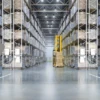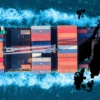Time to look into the future. Which technological trends are fundamentally transforming our logistics sector? How do we help build a sustainable future for our customers? In this blog post, we reveal our vision.
You won’t be surprised that the world will look completely different in 160 years. Dynamic and fast-changing, that’s the future for fashion and lifestyle brands and their logistics partners.
Looking at the past 160 years and the milestones in Bleckmann’s history confirms that nothing stays the same. Moreover, most of the future is unpredictable. Even founder Benjamin Bleckmann could not have predicted today’s society in 1862.
However, he did have a vision that took him and the company straight into the future. Starting from the customers’ needs, his Bleckmann evolved and transformed into the experts in fulfilment services for fashion & lifestyle brands as it is today.
Nurturing the past and with our strong market position in mind, we focus on the future. Our drive to innovate and collaborate, fuels the growth story of Bleckmann and our customers.
In this blog, we reveal our vision for the future.
Flexible solutions on customer demands
The world of fashion & lifestyle brands is evolving at lightning speed. The growing group of digital consumers determine trends, sales figures, popular articles and the growth of brands with clicks and swipes. Dynamic purchasing behavior translates into ever-new trends in logistics activities for fashion & lifestyle brands. The needs of our customers are therefore constantly changing.
Over the next 160 years, we will continue evolving along with developments in (online) retail and our customer needs. Flexible solutions are devised in consultation with our customers to suit their requirements.
Kurt Pierloot, Bleckmann’s CEO, emphasizes this asset of a personal approach: “We innovate together with our customers, this is how we find the best solutions to their challenges. Excelling day after day guarantees a successful future for our customers, also for us".
More digitization and automation
The future is digital. There is no doubt about that!
Many warehouse management innovations are built from software and hardware, which include a high degree of automation and artificial intelligence.
Nevertheless, the big leap to supply chain management in 2183 (160 years from now) will be taken step by step. Improvements will take place every day. New projects will first be developed in pilots. They grow through trial and error until they are ready to be rolled out across multiple brands and locations.
Robotics are taking on increased work. Automated systems are replacing manual labour and making the processes easier. Computers, sensors, tracking systems and smart hardware are becoming ubiquitous on the logistics work floor. Artificial intelligence and blockchain technology create new opportunities.
As a result, supply chain management runs smoother, faster than ever before as well more sustainable and becoming error-free. This is necessary to realize the growth ambitions of Bleckmann and its customers.
People help to create this future
The future workplace is not just populated by machines. Artificial intelligence will not do all the work, automation and digitalization will not just happen. In each case, it is our people who, design, install, maintain and optimize these systems.
“As a result, the focus in the coming years will be even more on giving people valuable work in coming up with solutions and writing out procedures to work together efficiently,” Kurt foresees. “People certainly remain central in a logistics company like ours, also into the future.”
The more than 5,000 Bleckmann employees will increasingly be digitally supported by and working alongside AI when serving our customers.
“Ensuring we excel in what we do: attracting and serving customers through talented and passionate employees. We do this in a corporate culture with four core values: Entrepreneurship, Expertise, Engagement and Excellence. This focus on our customers and people further gains value in the digital future.”
“The automation will also help us to continue finding enough people,” explains Kurt. “Today, around 150 vacancies remain unfilled. If Bleckmann doubles in activity, we would have to fill even more vacancies. Without automation, doubling activity equals doubling the number of people. Fortunately, automation will allow us to grow substantially with proportional fewer people and continue to provide excellent service at the right cost level.”
“Automation makes growth manageable in the future, as costs decrease in percentage terms and the service level increases.”
Flexible automation, sharing with more customers
Automation is also becoming more flexible. Today, we only automate in consultation with the customers who run sufficient volumes.
For a lot of smaller customers today, it is less advantageous to deploy customized automated systems. They are served more flexibly and economically by human hands and standard logistics distribution systems.
However, in the future, significant shifts can be expected in this domain through innovative ideas for more flexible and varied automated solutions. The plans we already have on our drawing boards today will revolutionize many smaller brands in B2B and B2C tomorrow.
“The multi-client automation we are working on shows the direction we are taking in the future,” Kurt clarifies. “Today, we are working out the idea. Then we will set up a pilot, build the innovation and launch it for several of our clients. The potential is huge. I compare it with our last-mile delivery solutions. These are very innovative. The choice of e-commerce at the turn of the century was extremely innovative. I dare to predict that the innovations we plan today have the potential to be even more revolutionary.”
A circular mindset leads to sustainable growth
Continuous improvement, as in digitalization also occurs in the sustainability field. Brands are often driven to become more sustainable by an intrinsic desire. Or they are motivated by their customers or legislators.
Bleckmann will become an essential link for fashion brands to offer more circular products, reduce CO2 emissions and continue to launch new recommerce initiatives.
“Starting from smaller, concrete initiatives, a sustainable mindset grew throughout the company. We help brands to become sustainable, even circular, today and into the future,” points out Ron Thijssen, Bleckmann’s CSR Manager. “We translate the concept of people, planet, profit into SMART actions that have an impact, linked to UN Sustainable Development Goals. Among other things, we drastically reduce the CO2 footprint through concrete climate actions. We ensure fair work and economic growth and forge partnerships to achieve these goals.”
A solid example of how we are helping to build the future? In Almelo, Bleckmann is building the largest circular distribution centre in the Netherlands.
“The Renewal Workshop also shows our vision of the future and how we roll up our sleeves to build a more sustainable future,” says Steven Rymenans, Head of Digital & Innovation “We have the ambition to be part of the solution to the climate problem. A container of old textiles, for example, will be the raw material for new T-shirts.”
“In the future, production and consumption chains will be circular. That’s where logistics partners play a central role. With TRW, we offer fashion brands a concrete solution to set steps in this new direction. Today, they can already have items repaired instead of writing them off as a loss. We offer brands a solution with which they can encourage their customers to consume less. Consumers can also be happy or even happier by purchasing less. Brands that invest in this area are already writing a great success story today.”
A wider network of sustainable carriers
The future belongs to partner organizations and brands that are part of a strong network. In the logistics world, these networks are global and diverse. They are strong locally and internationally and have fast and sustainable transport solutions.
Our international network is constantly expanding and greening. We have the ambition to reduce CO2 emissions. Plans to realize this ambition are being rolled out gradually.
Kurt expresses this transition is also visible in the last mile delivery: “Brands and consumers want to reduce their ecological footprint, among others, by choosing a sustainable carrier. Through flexible solutions and our many partners, they can choose bicycle couriers, suppliers with parcel machines, bundled shipments, and so on. Something for everyone. Thanks to this large offer, more and more customization is possible.”
The future is local
Even if the future is mainly virtual and consumers will buy from location-independent fashion and lifestyle brands, location will matter more and more in the future. As a result of digital actions, today, physical goods are shipped from producing countries to distribution centres and finally end up with end consumers.
In the coming years, the location of production and distribution centres will shift towards the location of end consumers. At the origin of this trend are unstable supply lines, high transport and environmental costs, a congestion-sensitive road network and political and social problems in (former) low-wage countries. In addition, consumers value local production.
Reshoring will be part of this trend. Reshoring means bringing production back from overseas to the regions where the production initially took place and where most consumers live. This trend of reshoring creates opportunities to personalize production and make it more sustainable, for example, with 3D printers that work locally and on demand. Or through reusing waste material, which is first turned into raw materials. When weeks-long supply lines are replaced by flexible, short supply lines, expensive and risky stocks can be significantly reduced.
Linked to this, brands serving European consumers choose distribution centres centrally in Europe. Brands with consumers in the UK and US want to be served from central locations in the UK and US, respectively.
Here we can play a trump card, Kurt stresses: “Bleckmann’s excellent geographical position with presences in Central Europe, the UK and the US is a reason for customers to choose for us. From our distribution centres, we smoothly serve their entire customer community in Europe, the UK and the US.
This trend will continue. In the future, global rhymes with local. Production and logistics will be brought closer together.
Cybersecurity will be more important than ever
Invisible cyber-criminals constantly target all these processes, businesses, data networks and cloud infrastructure. Brands and companies that want to stand firm in the future do their best to arm themselves against growing and more aggressive cybercrime. In doing so, they prevent significant damage and become attractive partners for other companies. Cybercriminals can easily penetrate companies via another company, so the need for high supply chain cybersecurity is high.
“Already hackers are bombarding our network and Bleckmann team members’ mailboxes with an extremely high number of intrusion attempts per day!” Kurt says. “That number will only increase. One small human error is enough to make one of those attempts succeed.”
Despite state-of-the-art cybersecurity solutions, the number of cyber-attacks is increasing alarmingly. Fortunately, our defense systems are also getting better and better. Among other things, built-in artificial intelligence analyses and combats threats at lightning speed.
Nevertheless, organizations remain vulnerable because people are and will remain the weak link in organizations’ defenses for the next 160 years. One error of interpretation, one oversight, or one old password can open the gate to cyber-criminals. The future belongs to those companies who make their employees aware and alert for both visible and invisible attacks. That’s something we are undividedly committed to at Bleckmann.
Be inspired by our future vision to develop your own vision. Do not hesitate to call on our help as a future-oriented logistics partner.














